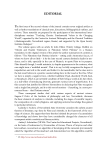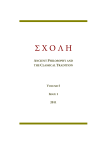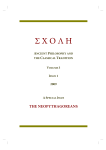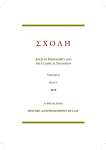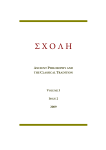Schole. Философское антиковедение и классическая традиция @classics-nsu-schole
Статьи журнала - Schole. Философское антиковедение и классическая традиция
Все статьи: 733
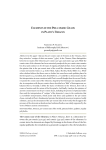
Elements in the Pre-cosmic Chaos in Plato’s Timaeus
Статья научная
In this paper I discuss the pre-cosmic state of elements in the Timaeus, when they existed as “vestiges of their own nature” (53b2). In the Timaeus, Plato distinguishes between two states of the elements: pre-cosmic (47e-53c) and cosmic (53c-57d). While the cosmic state of the elements has been extensively analyzed, the pre-cosmic state remains less clear and continues to be the topic of ongoing scholarly debate. Some scholars share the opinion that in the pre-cosmic state of the world the elements were bodies having certain stereometric forms (e. g. Archer-Hind, Taylor, Mortley, Mohr, Miller etc.). While other scholars believe that there were no bodies, but some forces and qualities placed in the Receptacle (e. g. Cornford, Zeyl, Waterfield etc.). I would like to demonstrate that the first interpretation is more consistent with Plato's overall thought than the second. Firstly, I examine the cosmic state of the elements, shaped by the Demiurge into regular polyhedra, in comparison with the pre-cosmic chaos, described as a "field" of heterogeneous, unbalanced forces. Secondly, I define the status of elements in the Timaeus, their role as causes of motion, and the nature of the Receptacle. And finally, I analyze the opinions of ancient commentators on the pre-cosmic chaos, including the presence of primary bodies there and the interpretation of "vestiges" of the elements. I came to the conclusion, that (1) Cornford's interpretation, which posits only forces and qualities in the pre-cosmic chaos, contradicts Plato's fundamental premise that physical movement requires a bodily substrate.; and (2) the description of the pre-cosmic state of the world, which suggests the presence of the elements as disordered and unformed bodies, was widely supported by the views of Plato's ancient commentators.
Бесплатно
![Etymology of the nickname 'Iskarit(h): the “one who saw a sign” [('I)sqar(^i)'^o/yisqar(^i)'^o] or the “one who slandered/betrayed a sign” [('I)sqar(^i)'^o/yisqar(^i)'^o]? Etymology of the nickname 'Iskarit(h): the “one who saw a sign” [('I)sqar(^i)'^o/yisqar(^i)'^o] or the “one who slandered/betrayed a sign” [('I)sqar(^i)'^o/yisqar(^i)'^o]?](/file/thumb/147103397/etymology-of-the-nickname-iskarit-hthe-one-who-saw-a-sign-i-sqar-i.png)
Статья научная
The article derives Judas's nickname 'Iskariṓt(h) from the Hebrew/Aramaic verb sāqar/seqar, and the noun 'ōṯ/'ôṯ (widely used in Biblical Hebrew and attested in the Talmud [=Aramaic 't/'t']), and interprets it as the “one who saw/gaze upon a sign” (cf., e.g., John 2:23, 4:48, 6:2,14,30 mentioning those who «saw signs» and came to be Jesus's followers; the verbs theōréō and ‘oráō used in these passages correlate with the verb sāqar/seqar, “to look (at), gaze, see”, and the noun sēmeîon (pl. sēmeîa) correlates with the term 'ōṯ/'ôṯ, “sign”). The ex hypothesi “positive” character of Judas's nickname possibly explains the evangelists' renunciation of its interpretation. As an alternative etymology of Judas's nickname 'Iskariṓt(h), one can derive it from the Hebrew/Aramaic verb šāqar/šeqar (“to lie, deceive, slander”, sc. “to violate (a treaty, etc.)”, “to betray” [the latter meaning is attested in Samaritan Aramaic]) and the same noun 'ōṯ/'ôṯ: the “one who slandered/resp. betrayed a sign”, i.e. the one who brought false evidence against Jesus (сf.: Matt. 26:59 ff.; Mk. 14:55 ff.). In Jn. 6:70, Jesus himself defines Judas with the term diábolos; this word can be interpreted as “slanderer”, “accuser”.
Бесплатно
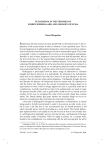
Eudamonia in the theories of Soren Kierkegaard and Gregory of Nyssa
Статья научная
Panos Eliopoulos (University of Athens) carries out a comparative analysis of the concept of happiness of two Christian philosophers who lived at different times and in different cultural traditions, Søren Kierkegaard and Gregory of Nyssa.
Бесплатно
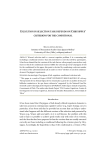
Execution in selection task depends on Chrysippus’ criterion for the conditional
Статья научная
Wason’s selection task is a current cognitive problem. It is a reasoning task including a conditional sentence that only sometimes is correctly solved by participants. It has been claimed that the versions of the task that are often properly executed are only those in which the conditional sentence fulfills the criterion given by Chrysippus of Soli for the conditional. In this paper, this point is checked by considering a relevant number of versions of the aforementioned task in order to review whether or not their conditionals meet Chrysippus’ requirement.
Бесплатно

Federico Fellini and Homer: Parallels and intersections
Статья научная
This essay is an outgrowth of the topic considered in the previous articles devoted to the image of ancient and modern Rome in Federico Fellini’s films, in which an attempt to analyse several Homeric motifs in Fellini Satyricon (1969) was made. The Italian film director acknowledged that he had dreamed to make a film based on the European ‘Book of the Books’, Homer’s duology – the Iliad and the Odyssey – about the heroes of the Trojan cycle of myths. Other coincidences in Fellini and Homer constitute the object of this study. Deliberate? Fortuitous? Archetypic? Fanciful? The very wording of the topic – Fellini Satyricon as Fellini’s Iliad – is provocative. The article identifies and discusses the parallels and intersections in the works of the two great masters – the Ancient Greek poet and the classic of Italian cinematograph, who lived almost three millennia apart.
Бесплатно
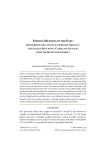
Статья научная
This paper offers a novel interpretation of the luxury golden ring with a carnelian intaglio depicting a woman's profile and an engraved Greek inscription, ΒΑCIΛICCΑ ΟΥΛΠIAΝΑ(Ζ)IA (or AΣIA E.A.), found in cist grave 14, in Mtskheta, Georgia, dated to the Roman period, the 3rd century AD. In consideration of the then contemporary political situation in the Mediterranean and Roman East, through the putting and interpreting sources into broad historical context, the author identifies the female individual as the Roman Empress Ulpia Severina. The very inclusion of royal woman within public propaganda during this period signifies her prominence within, and significance outside of, the imperial metropolis. This deliberate inclusion proved to the public that this empress was not mere figurehead but could have been a very influential person in the Empire.
Бесплатно
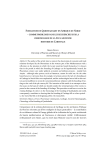
Статья научная
L'auteur de l'article tente de relier l'observation des relations économiques et commerciales développées par les Phéniciens dans la partie occidentale de la Méditerranée à une réflexion sur la situation dans laquelle se trouvaient les pays du Levant. On sait qu'à l'époque où la fondation de Carthage peut être hypothétiquement localisée, les centres phéniciens étaient sous pression politique, économique et militaire - principalement de l'Assyrie - bien que d'autres puissances, comme Damas, ne puissent être exclues. D'autre part, cependant, on sait que, par exemple, dans la science allemande l'absence d'acte fondateur de Carthage en Afrique du Nord a été soulignée, et les traces archéologiques laissées sur ce territoire semblent insuffisantes pour concilier les relations littéraires conventionnelles avec l'acte fondateur. de Carthage à la fin du IXe siècle av. L'intention de cet article est de tenter de montrer les enjeux à partir desquels il convient d'envisager la réinterprétation des événements rapportés dans le contexte de la fondation de Carthage. Cette démarche servirait à réviser les connaissances scientifiques existantes sur la chronologie de la fondation de Qarthadasht et pourrait, par conséquent, contribuer à montrer que la fondation de Carthage s'inscrit dans une période postérieure - c'est-à-dire la fin du VIIIe ou le début du VIIe. siècle avant notre ère.
Бесплатно
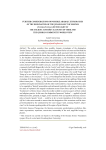
Статья научная
The author considers three possible Aramaic etymologies of the designation Ἐσσαῖοι/Ἐσσηνοί: (1) Since, according to reiterated Josephus Flavius' accounts and the Dead Sea scrolls' evidences, the Essenes and the Qumranites, closely associated with them, believed in predestination and foretold the future, they could be called: those, who believe in predestination, sc. the “fatalists”, “determinists”; or: those, who predict fate, i.e. the “foretellers”. This hypothetical etymology is derived from the Aramaic word ḥaššayyā᾿ (m. pl. in st. det.; resp. ḥš(᾿)(y)yn in st. abs.) reconstructed by the author from the term ḥšy/ḥš᾿ (“what man has to suffer, predestination, fortune”) after the model: C1aC2C2aC3. (2) In the present author's opinion, the Qumran community held itself allegorically to be the “root(s)” and “stock” of Jesse, giving life to the “holy" Davidic “Shoot” (see: Isa. 11:1); or, in other words, the Qumranites appear to have considered their Yaḥaḏ (lit. “Unity/Oneness”) the personification of a new Jesse, who would “beget” and “bring up” a new David. (Cf., e.g., 1QSa, II, 11-12: “When [God] begets (yôlîḏ) the Messiah with them (᾿ittām; i.e. the sectarians. - I. T.)...”.) Proceeding from this doctrine, one can assume the etymology of the designation Ἐσσαῖοι/Ἐσσηνοί from the Aramaic-Syriac spelling of King David father's name Jesse - ᾿Κ(š)ay. (3) The Essenes' and the Qumranites' aloofness from this world and their striving for interrelations with the other world could be a reason, by which they came to be regarded as “liminal” personalities and nicknamed (probably, with a tinge of irony) after the name of “rephaites” (the original vocalization seems to have been: rōfĕ᾿îm, lit. “healers”, sc. “benefactors”) of former times, whom they really recalled in some key aspects of their outlook and religious practice. In this case, the designation θεραπευταί, “healers”, - applied in Jewish Hellenized circles, primarily, in Egypt, to the members of the (ex hypothesi) Essenean communities of mystic-“gnostic” trend - could be in fact a Greek translation of the Hebrew term rōfĕ᾿îm. It also seems natural to assume that this designation of the sectarians could be interpreted/translated by the uninitiated by the word ᾿āsayyā᾿/᾿āsên, meaning “healers”, “physicians”, in the Aramaic-speaking milieu of the region of Syria-Palestine.
Бесплатно

Geometric patterns of the Konya Sultanate
Статья научная
Very few monuments have survived from the first two (11th–12th) centuries of the art of Islamic geometric ornamentation. The reason for this is the relative fragility of the used materials, and invasions and wars with their destruction. Compared to the previous era, the numerous surviving stone buildings of the 13th century in the Konya Sultanate provide a wealth of material for the study and classification of geometric ornamental patterns, dating back to previous centuries and invented by geometers and architects of that time.
Бесплатно

Geometric patterns of the palace of termez rulers
Статья научная
Archaeological expedition of Moscow Museum of Oriental Cultures, which worked in the 1930s at the site of Old Termez, excavated the ruins of a building identified as the Palace of Termez rulers. The interior of this building was decorated with stucco slabs contained various geometric patterns, together giving a rich collection of geometric design of the pre-Mongol era. This article classifies and analyzes the entire set of these patterns, numbering about three dozen. They are compared with geometric patterns of the same era on other architectural monuments of Khorasan.
Бесплатно
Статья научная
A small glass intaglio with the impressed portrait of Silenus was found in Galilee some years ago. By its technical and stylistic characteristics, it dates back to the Persian–Early Hellenistic period. Based on the general historical, cultural, and economic conditions of the period, it is supposed to have originated from one of the Greek islands, where the cult of Silenus emerged at that time and was imported to the Land of Israel. Amazingly, in the collection of E. Borowski, the exact glass duplicate of the gem with Silenus was encountered in the course of research (currently located in the Bible Land Museum). Such coincidences very rarely occur in research on small ancient objects. The discovery of this Pagan gem in Galilee sheds light on the spread of the Dionysiac cults and the development of the religious and economic links between the Land of Israel and the Classical Greek world.
Бесплатно

Harmony, order, and unity in Plato’s Laws
Статья научная
In Book X of Plato’s Laws , the motions of the body are contrasted with the changes of the soul. The latter are categorically different from the former. The soul is oriented in time while the body is oriented in space. Despite their differences, soul and body work in unison. When the senses are informed by λόγος, order is perceived and enacted. The coordination of soul and body is most evident in music and dance. A choral dance is a composition in which body and soul and their analogues, space and time, are unified. A city is an analogous composition. The relation between body and soul parallels the relation between a city on the one hand, and its laws, beliefs, and customs on the other. For these reasons, the highest order of a city is its religious order. The religious life of a city integrates time and space as well as soul and body. Religion serves as a binding power that harmonizes the city and its people.
Бесплатно

Статья научная
The paper has as its goal the investigation of the meaning of logos in DK frs. 1, 2, 31b, 39, 45, 50, 87, 108, and 115, with particular emphasis on frs. 1, 2 and 50. It is argued that the focal meaning of the term is ‘account’ or ‘statement’, and that the statement in question, of particular importance in frs 1, 2 and 50, it the account/statement forever being uttered by ‘that which is wise’, ( to sophon ), Heraclitus’ divine principle. Plato picks up the idea, with his notion of a World Soul which is similarly forever in a state of utterance (‘ legei ’, Tim. 37ab) which is a piece of self-description, and it is suggested that a modern version of the notion of the universe being in an everlasting state of such self-description is our ability to learn what it has to say by investigating the ‘language’ of radio waves and the like, which are forever being emitted by all moving systems composing the real, and thereby forever offering us a piece of the real’s self-description of itself.
Бесплатно
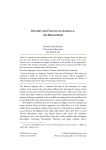
History and Fantasy on Acholius, the Biographer
Статья научная
Among the bogus authors cited in the Historia Augusta, there are some who turn out to be masks for real authors, as part of the picaresque aspect of the work. However, the vast majority are simply disregarded as the product of the biographer’s invention. One of them is Acholius, an author cited on four occasions. We believe that there are reasons to include him in the first group.
Бесплатно
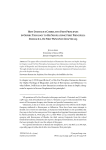
Статья научная
This paper offers a detailed analysis of Damascius' discourse on Orphic theology in Chapter 123 of On First Principles, focusing on how Damascius correlates the first principles of Rhapsodic and Hieronyman theogonies to his own Neoplatonic first principles. Through detailed textual analysis, it presents a schematic alignment of Damascian principles with Orphic theology.
Бесплатно

